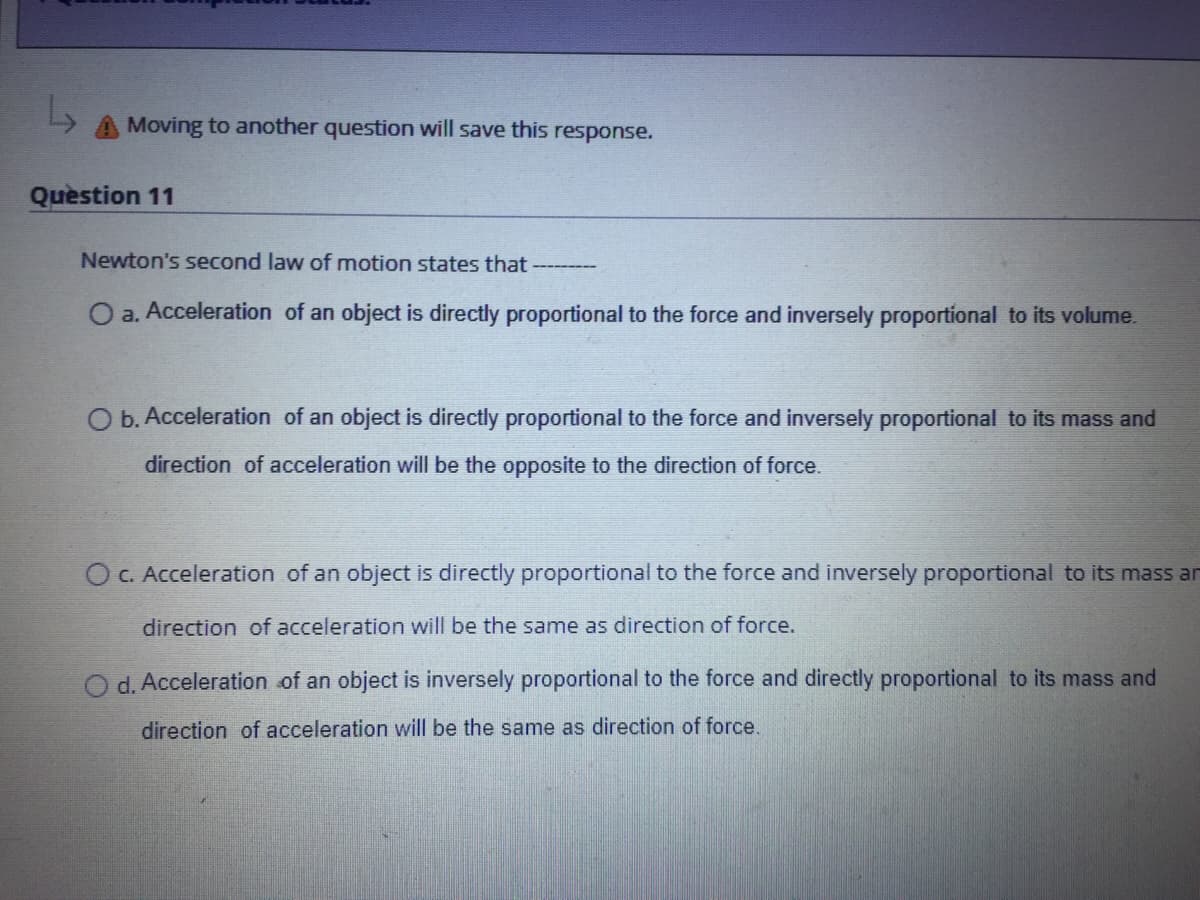Newton's second law of motion states that ------ O a. Acceleration of an object is directly proportional to the force and inversely proportional to its volume. O b. Acceleration of an object is directly proportional to the force and inversely proportional to its mass and direction of acceleration will be the opposite to the direction of force. O C. Acceleration of an object is directly proportional to the force and inversely proportional to its mass a direction of acceleration will be the same as direction of force. O d. Acceleration of an object is inversely proportional to the force and directly proportional to its mass and direction of acceleration will be the same as direction of force.
Newton's second law of motion states that ------ O a. Acceleration of an object is directly proportional to the force and inversely proportional to its volume. O b. Acceleration of an object is directly proportional to the force and inversely proportional to its mass and direction of acceleration will be the opposite to the direction of force. O C. Acceleration of an object is directly proportional to the force and inversely proportional to its mass a direction of acceleration will be the same as direction of force. O d. Acceleration of an object is inversely proportional to the force and directly proportional to its mass and direction of acceleration will be the same as direction of force.
College Physics
10th Edition
ISBN:9781285737027
Author:Raymond A. Serway, Chris Vuille
Publisher:Raymond A. Serway, Chris Vuille
Chapter4: The Laws Of Motion
Section: Chapter Questions
Problem 84AP: In Figure P1.84, the pulleys and the cord are light, all surfaces are frictionless, and the cord...
Related questions
Topic Video
Question

Transcribed Image Text:A Moving to another question will save this response.
Quèstion 11
Newton's second law of motion states that
O a. Acceleration of an object is directly proportional to the force and inversely proportional to its volume.
O b. Acceleration of an object is directly proportional to the force and inversely proportional to its mass and
direction of acceleration will be the opposite to the direction of force.
O C. Acceleration of an object is directly proportional to the force and inversely proportional to its mass an
direction of acceleration will be the same as direction of force.
d. Acceleration of an object is inversely proportional to the force and directly proportional to its mass and
direction of acceleration will be the same as direction of force.
Expert Solution
This question has been solved!
Explore an expertly crafted, step-by-step solution for a thorough understanding of key concepts.
This is a popular solution!
Trending now
This is a popular solution!
Step by step
Solved in 2 steps

Knowledge Booster
Learn more about
Need a deep-dive on the concept behind this application? Look no further. Learn more about this topic, physics and related others by exploring similar questions and additional content below.Recommended textbooks for you

College Physics
Physics
ISBN:
9781285737027
Author:
Raymond A. Serway, Chris Vuille
Publisher:
Cengage Learning

Glencoe Physics: Principles and Problems, Student…
Physics
ISBN:
9780078807213
Author:
Paul W. Zitzewitz
Publisher:
Glencoe/McGraw-Hill

College Physics
Physics
ISBN:
9781938168000
Author:
Paul Peter Urone, Roger Hinrichs
Publisher:
OpenStax College

College Physics
Physics
ISBN:
9781285737027
Author:
Raymond A. Serway, Chris Vuille
Publisher:
Cengage Learning

Glencoe Physics: Principles and Problems, Student…
Physics
ISBN:
9780078807213
Author:
Paul W. Zitzewitz
Publisher:
Glencoe/McGraw-Hill

College Physics
Physics
ISBN:
9781938168000
Author:
Paul Peter Urone, Roger Hinrichs
Publisher:
OpenStax College

Physics for Scientists and Engineers, Technology …
Physics
ISBN:
9781305116399
Author:
Raymond A. Serway, John W. Jewett
Publisher:
Cengage Learning